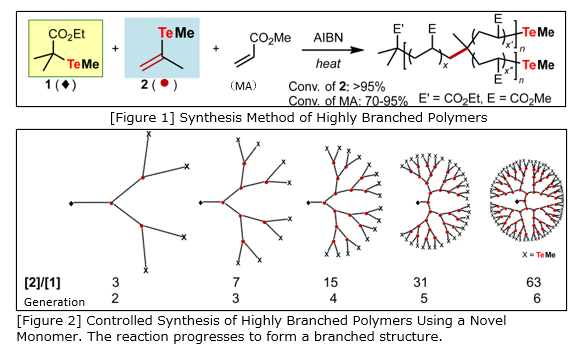Available Technologies
Recyclable and Self-Healing Highly Branched Polymers
This polymer enables material design based on the interactions of terminal groups in highly branched polymers, offering both recyclability and self-healing properties
Background
Plastics (synthetic polymers) are widely used as indispensable materials in modern society due to their high functionality and low cost. However, the large volume of used plastics has caused severe environmental issues. Traditional plastic recycling methods can be categorized into two types: physical recycling, which involves mechanical breakdown and separation of materials, and chemical recycling, which decomposes plastics into monomers. In general, the former leads to a decline in the physical properties and functionality of the recycled material, while the latter involves high environmental impact processes.
Description and Advantages
The inventors have developed a novel polymer synthesis method that replaces the conventional "polymer chain entanglement" in linear polymers with "interactions among the terminal groups of highly branched polymers." This approach allows for the simultaneous achievement of "elastomeric properties" and "degradability into monomers," or the ability to control the balance between the two. As a result, it enables the development of recyclable polymer materials. Furthermore, self-healing properties have also been observed, making this technology a promising solution to the global plastic waste problem.
[ Key Features ]
⮚Hyperbranched Polymers
•Hyperbranched polymers with a controlled 3D dendritic structure can be synthesized via the living radical polymerization of monomer molecules (2)*, an organic tellurium polymerization control agent (1), and acrylic acid ester (MA) [Figure 1] (*JP6754124).•The synthesis process is simple, and the branching structure (branch number and branch density) can be easily controlled [Figrure 2].
⮚Formation of "Polymer Aggregated States" via Terminal Group Interactions
By introducing interactive terminal groups at the ends of the multibranched polymer, a "polymer aggregated state" can be formed through terminal group interactions, which leads to plasticorelastomer physical properties appear.
⮚Recyclability
The polymer can be easily decomposed into monomers through a low-energy process using a solvent.
⮚Self-Healing Properties

| Development Status |
•Verification of elastomeric properties, self-healing ability, and recyclability. |
|---|---|
| Publication | ➢ Hyperbranched Poly(octadecyl Acrylate)s as Lubricant Additive Studied by Resonance Shear Measurement ➢ One-Step Synthesis of Dendritic Highly Branched Polystyrenes... |
| Offer | •Joint research •Licensing agreements •Option contracts |
| Related Links | View PDFView in Japanese |
Have you found what you were looking for?
- Interested in a particular research activity
- Cannot find the information
- Have questions on how to utilize research results
Feel free to contact us and get answers to your questions.
Inquiry- TLO-KYOTO
- Available Technologies
- Recyclable and Self-Healing Highly Branched Polymers
3rd Floor, International Science
Innovation Building, Kyoto University
Yoshidahonmachi, Sakyo-ku, Kyoto
606-8501 JAPAN


